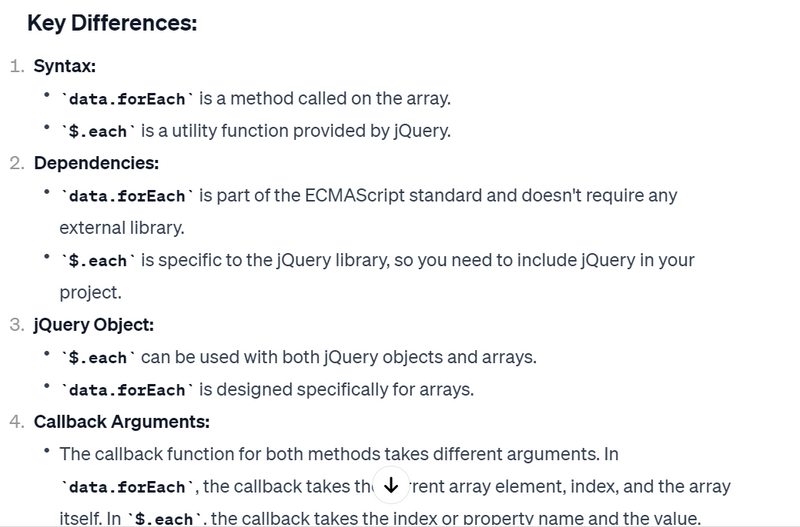Let's explore more examples to illustrate the differences between data.forEach and $.each:
Example 1: Using data.forEach
// Assuming data is an array of numbers
var numbers = [1, 2, 3, 4, 5];
// Using data.forEach to square each number
numbers.forEach(function(number) {
console.log(number * number);
});
Example 2: Using $.each
// Assuming paginatedData is an array of numbers
var numbers = [1, 2, 3, 4, 5];
// Using $.each to square each number
$.each(numbers, function(index, number) {
console.log(number * number);
});
In both examples, we iterate through an array of numbers and log the square of each number. The syntax and functionality are quite similar.
Example 3: Using data.forEach with Additional Arguments
// Assuming data is an array of names
var names = ["Alice", "Bob", "Charlie"];
// Using data.forEach to log names with a greeting
names.forEach(function(name) {
console.log("Hello, " + name + "!");
});
Example 4: Using $.each with Additional Arguments
// Assuming paginatedData is an array of names
var names = ["Alice", "Bob", "Charlie"];
// Using $.each to log names with a greeting
$.each(names, function(index, name) {
console.log("Hello, " + name + "!");
});
Here, we are adding a greeting message to each name. The examples show that the callback function for both data.forEach and $.each can take additional arguments beyond the current element and index.
Example 5: Using $.each with jQuery Objects
// Assuming resultContainer is a jQuery object
var resultContainer = $('#resultContainer');
// Using $.each to append elements to a container
$.each([1, 2, 3], function(index, value) {
resultContainer.append('<p>' + value + '</p>');
});
In this example, $.each is used to iterate through an array and append
elements to a jQuery object (resultContainer). This showcases that $.each can work seamlessly with jQuery objects.
Summary:
- Both data.forEach and $.each can be used for iterating through arrays.
- data.forEach is part of the JavaScript language and is used for arrays.
- $.each is a utility function provided by jQuery, and it can handle both arrays and jQuery objects .


Top comments (0)